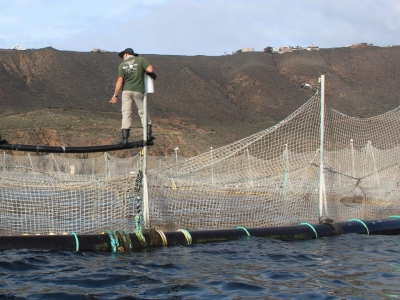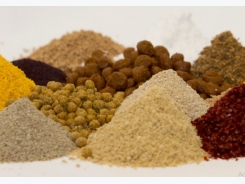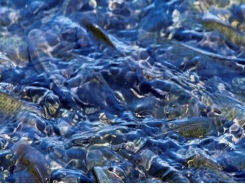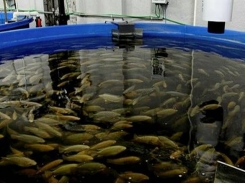Tuna aquaculture: Fishing for progress

New research brings commercial scale tuna aquaculture closer to reality
Researchers at Ichthus Unlimited aren testing soy-based diets for larval Atlantic bluefin tuna in Spain and for juvenile yellowfin tuna in land-based facilities in Panama.
Demand for tuna far exceeds supply. Wild populations of juvenile bluefin tuna are, according to Pew Charitable Trusts, just 3 percent of their original size as a result of overfishing and the capture of juveniles for tuna ranching in places like the Mediterranean Sea.
Aquaculture could be a sustainable alternative to raising bluefin, blackfin and yellowfin tuna but achieving commercial-scale production has proven challenging.
Daniel Benetti, Ph.D., director of aquaculture at the University of Miami, cites two main barriers to successful tuna aquaculture: Reliable mass production of juvenile tuna species in captivity and producing feed that is economically and environmentally efficient while also meeting tuna’s complex nutritional requirements.
“The entire world is trying to crack the code,” Benetti said.
So far, most of those efforts have failed.
Rearing tuna is troublesome so eggs are often shipped to research facilities; for those that hatch, survivorship of larval tuna is low, making it almost impossible to research their nutritional requirements. In Hawaii, Syd Kraul of Pacific Planktonics tried – and failed – to overcome both issues.
In 2010, Kraul received a U.S. Department of Agriculture grant to rear yellowfin tuna from egg to adult. It took two years just for the tuna to spawn; Kraul induced them but the egg quality suffered. The fish that survived ate each other or crashed into the tank walls and died. Still, Kraul remains optimistic about the future of tuna aquaculture. “There are clues that it can be viable,” he said.
The most promising progress thus far has happened in Japan. In 2002, Kindai University made headlines as the first in the world to breed bluefin tuna using full-cycle aquaculture. The breeding and rearing of its so-called Kindai tuna has been so successful that the university started releasing juvenile tuna into the ocean to help replenish wild tuna populations.
Kindai University also earned additional accolades for its partnership with Australia-based aquaculture enterprise Clean Seas to get bluefin tuna to spawn in tanks. TIME magazine named the tank-bred tuna one of the Best Inventions of 2009. Clean Seas has since discontinued its bluefin breeding efforts to focus on yellowtail kingfish production. The company did not respond to interview requests to be interviewed for this story.
There has been so much effort over so many years, the time has come.
More recently, two new research projects were launched with a goal of advancing progress toward sustainable tuna aquaculture.
In May, the University of Miami signed a $1.5 million collaborative research agreement with Aqquua LLC to study the reproduction and nutritional requirements of several high value fish species, including tuna. The team will travel to Panama this summer to conduct research using broodstock from the Inter-American Tropical Tuna Commission with the hope of optimizing aquaculture technologies to achieve commercial scale production.
“There has been so much effort over so many years, the time has come,” said Benetti.

There are two main barriers to successful tuna aquaculture: Reliable mass production of juvenile tuna species in captivity and producing feed that is economically and environmentally efficient while meeting tuna’s complex nutritional requirements. Photo courtesy of Daniel Benetti, Ph.D., director of aquaculture at the University of Miami.
A new breakthrough in tuna feed also shows promise.
With funding from the Illinois Soybean Association checkoff program, researchers at Ichthus Unlimited tested soy-based diets for larval Atlantic bluefin tuna in Spain and for juvenile yellowfin tuna in land-based facilities in Panama. The proprietary formulation successfully decreased the feed conversion ratio from 28:1 (pounds of feed for every pound of fish produced) feeding the fish wild-caught sardines to just 4:1 with the soy feed.
The soy-based feed floats, allowing researchers to monitor consumption and retrieve uneaten food, making it an economical and environmentally friendly option.
The initial formulation costs $2,500 per metric ton (compared with $450 for the same amount of sardines) but thanks to the lower feed conversion ratio, Ichthus Unlimited president Alejandro Buentello notes, “It’s $1,000 cheaper to raise one metric ton of tuna using our feed.”

A new soy-based formulation successfully decreased the feed conversion ratio from 28:1 just 4:1.
Buentello hopes new formulations, which he expects to be available commercially in late 2018, will be even more cost-effective.
“We’re betting that tuna aquaculture is going to go through a revolution,” said Mark Albertson, director of strategic market development for the Illinois Soybean Association. “But that revolution is only possible if the economics work out.”
Benetti agrees, citing public-private partnerships as an essential to the success of commercial-scale tuna aquaculture, noting that universities couldn’t undertake these ambitious – and expensive – projects on their own.
“It isn’t until the private sector gets involved that we’ll have the resources for the important work to happen,” he said.
Despite his enthusiasm, Benetti believes the success of tuna aquaculture will be species-dependent.
In Japan, there has been success raising northern bluefin tuna and ongoing work in the Mediterranean has advanced knowledge of raising Atlantic bluefin but is still quite far from commercial reality; southern bluefin, Benetti believes, “Is not happening.” It’s yellowfin, he says, that shows the most promise.
“Yellowfin aquaculture has come to the front burner,” he says. “The research is happening and it’s not whether but when anyone will be able to produce yellowfin in mass quantities.”
About Author: Jodi Helmer is a North Carolina-based journalist covering the business of food and farming.
Related news
Tools

Phối trộn thức ăn chăn nuôi

Pha dung dịch thủy canh

Định mức cho tôm ăn

Phối trộn phân bón NPK

Xác định tỷ lệ tôm sống

Chuyển đổi đơn vị phân bón

Xác định công suất sục khí

Chuyển đổi đơn vị tôm

Tính diện tích nhà kính

Tính thể tích ao




 Will Fish Farming Overtake Cattle Ranching?
Will Fish Farming Overtake Cattle Ranching?  Sea weed: Researchers get tilapia high to reduce…
Sea weed: Researchers get tilapia high to reduce…